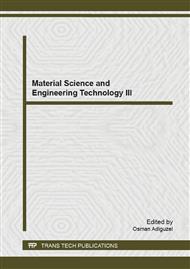p.322
p.330
p.336
p.340
p.344
p.348
p.355
p.361
p.368
Characterization of Thermal Conductivity and Viscosity of Nanofluids with Aqueous Base Fluids
Abstract:
Two different nanofluids (SiO2 – EG/DW and SiO2 – DW) with various volume fractions are prepared by dispersing SiO2 nanoparticles (< 20 nm) into two different types of base fluid: distilled water and ethylene glycol/distilled water mixture. The effective thermal conductivity and viscosity of nanofluids are characterized and compared over a temperature range of 25oC - 50oC. It is found that the effective thermal conductivity and viscosity of nanofluid are influenced by the nanoparticle volume fraction and the operating temperature. The thermal conductivity of the SiO2 nanofluids with different volume concentrations increases as temperature increases while the viscosity decreases with the increasing temperature. The base fluid alters the characteristics of both the thermal conductivity and viscosity of nanofluid. Over the same range of operating temperature, the effective thermal conductivity and viscosity of SiO2 – EG/DW nanofluid manifest stronger dependency on the nanoparticle concentration compared to those of water-base-fluid nanofluid.
Info:
Periodical:
Pages:
344-347
Citation:
Online since:
April 2015
Authors:
Keywords:
Price:
Сopyright:
© 2015 Trans Tech Publications Ltd. All Rights Reserved
Share:
Citation:


